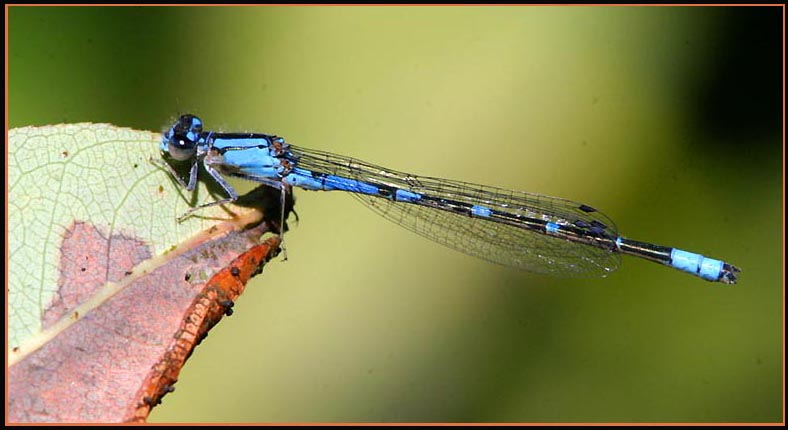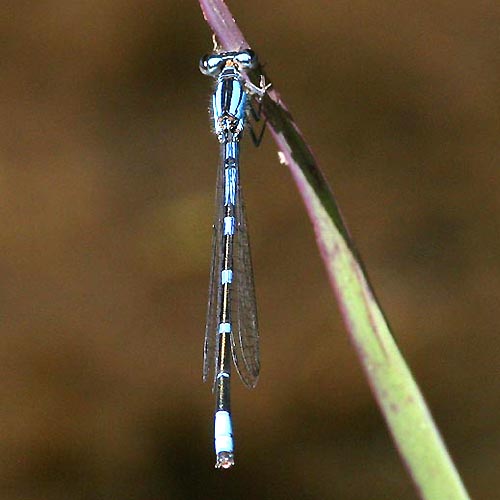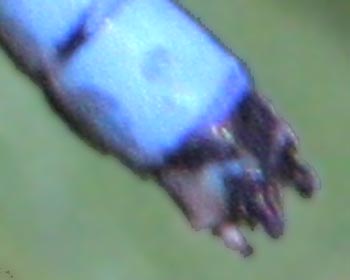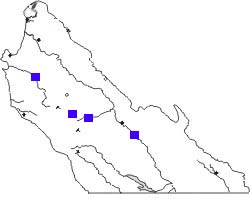| |
|
|
ARROYO BLUET
Enallagma
praevarum
|

photo (above &
next 2 below) 7 Oct 2006
Carmel River at Garland Ranch
Regional Park
|
 Arroyo
Bluet is one of the blue-and-black bluets in Monterey County (or at
least
the males are blue-and-black; females are tan-and-black but none are
shown
on this page). But males do separate into two groups if one focuses on
the middle abdominal segments — numbers 3, 4, and 5. In MTY there are
only
two species — Arroyo and Tule — whose segments are more black than
blue. Segment 3 is variable but 4 and 5 and definitely more black than
blue. All other MTY bluets (and most other California bluets to boot)
have
these segments decidedly more blue than black. Arroyo
Bluet is one of the blue-and-black bluets in Monterey County (or at
least
the males are blue-and-black; females are tan-and-black but none are
shown
on this page). But males do separate into two groups if one focuses on
the middle abdominal segments — numbers 3, 4, and 5. In MTY there are
only
two species — Arroyo and Tule — whose segments are more black than
blue. Segment 3 is variable but 4 and 5 and definitely more black than
blue. All other MTY bluets (and most other California bluets to boot)
have
these segments decidedly more blue than black.
Separating Arroyo from Tule Bluet is not easy, but
they have different
habitats. Arroyo Bluet is an ode of running water — streams, rivers,
rivulets
— while Tule Bluet is typically an ode of open marsh or pond edge.
However,
rather little information has been collected on either species in MTY,
and their comparative distribution is not yet known. The two specimens
from the county are from the Salinas and Arroyo Seco rivers. The latter
is the only spot at which Tule Bluet has also been confirmed to be
present
with Arroyo Bluet (but probably in quite different habitat).
|
 If
one nets the male bluet and examines it with a 10x lens — or can view
the
appendages at close range through digital photography (left) — Arroyo
Bluet
is identified by its distinctive two-pronged cerci. In this view (left)
the pair of cerci can be seen side-by-side. We have a good view of the
left-hand set nearest to us, but can see part of the right-hand set
also. Looking at the near set of appendanges,
distinguish
between the lower pale hook (the paraproct) and the black upper
appendange
(the cerci). Note that the upper appendage is forked with a long upper
fork and a comparatively short and pointed lower fork. To me this looks
like an old-fashioned can-opener. This can-opener shape identifies a
male
Arroyo Bluet, as it is quite different from Tule. However, River Bluet E. anna,
which occurs in eastern California, also has a two-pronged
cerci
and is much more similar to Arroyo Bluet in this feature. River Bluet,
though, has more blue than black in the middle abdominal segments.
[Females
have different appendages and female Arroyo probably cannot be
identified
from other bluets in the field; Manolis 2003]. If
one nets the male bluet and examines it with a 10x lens — or can view
the
appendages at close range through digital photography (left) — Arroyo
Bluet
is identified by its distinctive two-pronged cerci. In this view (left)
the pair of cerci can be seen side-by-side. We have a good view of the
left-hand set nearest to us, but can see part of the right-hand set
also. Looking at the near set of appendanges,
distinguish
between the lower pale hook (the paraproct) and the black upper
appendange
(the cerci). Note that the upper appendage is forked with a long upper
fork and a comparatively short and pointed lower fork. To me this looks
like an old-fashioned can-opener. This can-opener shape identifies a
male
Arroyo Bluet, as it is quite different from Tule. However, River Bluet E. anna,
which occurs in eastern California, also has a two-pronged
cerci
and is much more similar to Arroyo Bluet in this feature. River Bluet,
though, has more blue than black in the middle abdominal segments.
[Females
have different appendages and female Arroyo probably cannot be
identified
from other bluets in the field; Manolis 2003]. |
|
 Arroyo
Bluet is not yet well surveyed in MTY. The confirmed records are all
from
creeks and rivers with good currents: Carmel, Salinas, and Arroyo Seco
rivers, and Piney Creek. Reports from Laguna Grande in Seaside need
further
verification. Some of the habitats have been heavily wooded (e.g.,
Carmel
River) but others are more open (e.g., Salinas River south of San
Ardo). Arroyo
Bluet is not yet well surveyed in MTY. The confirmed records are all
from
creeks and rivers with good currents: Carmel, Salinas, and Arroyo Seco
rivers, and Piney Creek. Reports from Laguna Grande in Seaside need
further
verification. Some of the habitats have been heavily wooded (e.g.,
Carmel
River) but others are more open (e.g., Salinas River south of San
Ardo).
Dates range from 18 April to 7 October. This
is very close to the flight
dates known from the State (March-October; Manolis 2003).
|
|
|
Literature cited:
- Manolis, T. 2003. Dragonflies and Damselflies of
California. Univ. of
Calif.
Press, Berkeley.
Web resources:
Major identification web sites with much information on California
odes include:
For sites with excellent photos to compare for identification or to
simply
enjoy, see:
Many of these sites have links to other useful pages. Kathy Biggs's
site
is particularly useful in her selection of links. |
|
All photos © Don Roberson 2007
TOP
|
|
|
|
|
|
|
|
|
